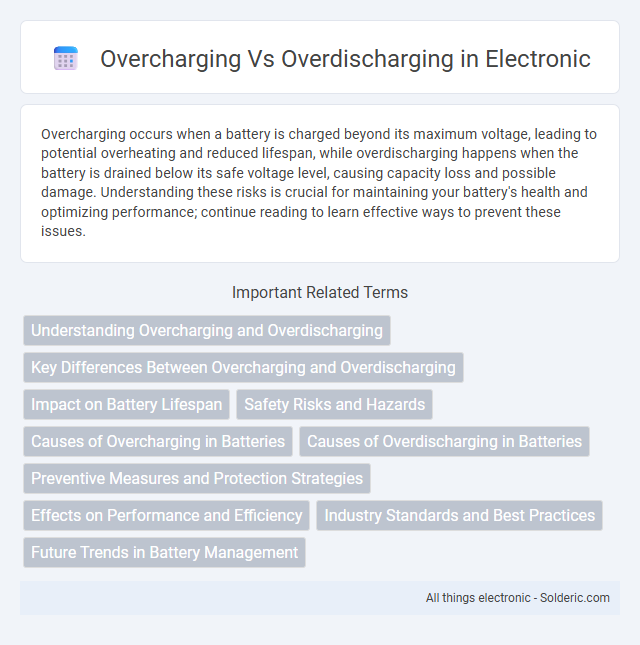Overcharging occurs when a battery is charged beyond its maximum voltage, leading to potential overheating and reduced lifespan, while overdischarging happens when the battery is drained below its safe voltage level, causing capacity loss and possible damage. Understanding these risks is crucial for maintaining your battery's health and optimizing performance; continue reading to learn effective ways to prevent these issues.
Comparison Table
| Aspect | Overcharging | Overdischarging |
|---|---|---|
| Definition | Charging a battery beyond its maximum voltage limit. | Discharging a battery below its minimum voltage threshold. |
| Voltage Impact | Exceeds recommended voltage (e.g., >4.2V for lithium-ion). | Drops below recommended cutoff voltage (e.g., <3.0V for lithium-ion). |
| Battery Damage | Causes electrolyte breakdown, swelling, and potential thermal runaway. | Leads to capacity loss, increased internal resistance, and cell imbalance. |
| Safety Risks | High risk of fire, explosion, and permanent damage. | Risk of deep discharge reducing battery life; lower immediate fire risk. |
| Performance Effect | Decreases cycle life and capacity quickly. | Reduces usable capacity and may cause irreversible damage. |
| Prevention Methods | Use of voltage cutoff, smart chargers, and battery management systems (BMS). | Use of low-voltage cutoff, BMS, and regular monitoring. |
| Common in | Improper charging with non-compatible chargers or faulty BMS. | Excessive device usage without recharging or battery self-discharge. |
Understanding Overcharging and Overdischarging
Overcharging occurs when a battery is charged beyond its maximum voltage, leading to excessive heat generation and potential damage to the battery's internal structure. Overdischarging happens when a battery is drained below its safe voltage threshold, causing capacity loss and making it difficult to recharge. Proper battery management systems help protect Your devices by preventing both overcharging and overdischarging, ensuring extended battery life and optimal performance.
Key Differences Between Overcharging and Overdischarging
Overcharging occurs when a battery is charged beyond its maximum voltage limit, leading to excessive heat, reduced lifespan, or potential safety hazards. Overdischarging happens when a battery is drained below its minimum voltage threshold, causing capacity loss, voltage drop, and possible irreversible damage. Understanding these key differences helps you maintain battery health and optimize device performance.
Impact on Battery Lifespan
Overcharging lithium-ion batteries causes excessive heat and chemical breakdown, significantly reducing battery lifespan by damaging the anode and cathode materials. Overdischarging leads to irreversible capacity loss due to the formation of copper dissolution and electrolyte degradation, impairing battery performance over time. Both conditions accelerate aging, but preventing overcharging is critical to maintaining optimal cycle life and battery health.
Safety Risks and Hazards
Overcharging lithium-ion batteries causes excessive heat buildup, increasing the risk of thermal runaway, fires, and explosions. Overdischarging leads to irreversible capacity loss and can cause internal short circuits, which may also result in battery swelling or leakage of hazardous chemicals. Both conditions severely compromise battery safety and longevity, emphasizing the need for proper charge management systems.
Causes of Overcharging in Batteries
Overcharging in batteries primarily occurs due to improper charging voltage or current exceeding manufacturer specifications, often caused by faulty chargers or malfunctioning battery management systems (BMS). Excessive heat generated during charging or prolonged exposure to high voltage leads to electrolyte decomposition and internal pressure buildup. Environmental factors such as high ambient temperature and degraded battery cells also contribute significantly to overcharging risks.
Causes of Overdischarging in Batteries
Overdischarging in batteries occurs when a battery is drained beyond its minimum voltage threshold, often caused by prolonged use without recharging or faulty battery management systems. This condition can result from devices continuing to draw power even after the battery is depleted, leading to irreversible capacity loss or battery failure. Understanding these causes helps you prevent performance degradation and extend your battery's lifespan.
Preventive Measures and Protection Strategies
Battery management systems (BMS) play a crucial role in preventing overcharging and overdischarging by continuously monitoring voltage levels and temperature to maintain optimal charge ranges. Implementing protective circuitry such as voltage cut-off thresholds and current limiters helps safeguard lithium-ion batteries from damage caused by exceeding charge or discharge limits. Regular maintenance, such as calibrating charge controllers and avoiding deep discharge cycles, further extends battery lifespan and ensures safe operational performance.
Effects on Performance and Efficiency
Overcharging a battery leads to excessive heat generation, accelerating capacity loss and decreasing overall efficiency, while overdischarging causes deep voltage drops that result in irreversible damage to battery cells and reduced cycle life. Both conditions impair battery performance by reducing charge retention and increasing internal resistance, which negatively impacts your device's runtime and reliability. Maintaining optimal charge levels prevents efficiency degradation and extends the effective lifespan of your energy storage system.
Industry Standards and Best Practices
Industry standards such as IEC 62133 and UL 2054 establish strict voltage and current limits to prevent overcharging and overdischarging in lithium-ion batteries, ensuring safety and longevity. Best practices emphasize the use of battery management systems (BMS) that monitor state of charge, implement cutoff thresholds, and balance cells to mitigate risks associated with charge extremes. You can enhance battery performance and safety by adhering to these standards and integrating advanced protection circuitry in your applications.
Future Trends in Battery Management
Future trends in battery management focus on advanced algorithms and AI-driven systems to prevent overcharging and overdischarging, thereby enhancing battery lifespan and safety. Integration of real-time monitoring through IoT-enabled sensors enables predictive maintenance, reducing risks of thermal runaway and capacity loss. Development of solid-state and ultra-fast charging batteries requires sophisticated state-of-charge estimation techniques to balance energy density with protection against voltage extremes.
Overcharging vs Overdischarging Infographic

 solderic.com
solderic.com